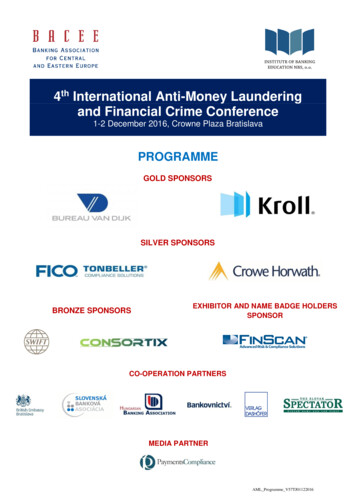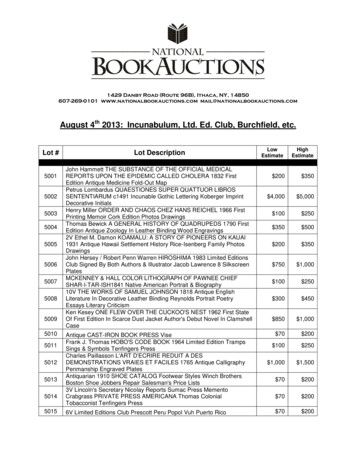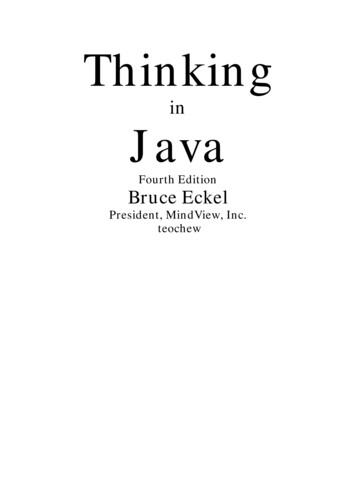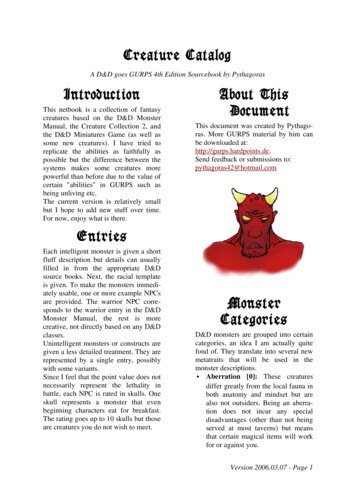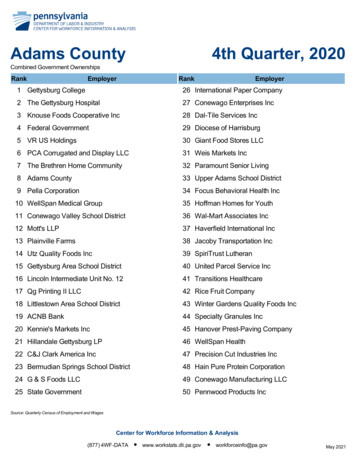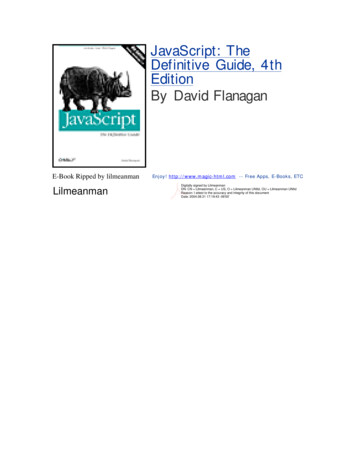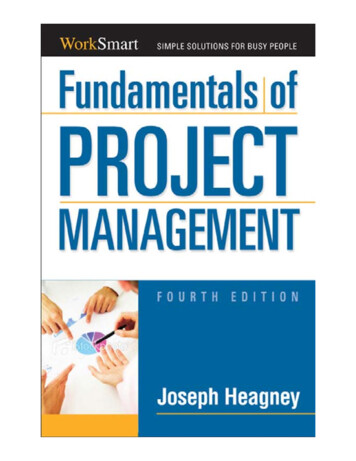
Transcription
Fundamentals ofProject ManagementFourth Edition
This page intentionally left blank
Fundamentals ofProject ManagementFourth EditionJOSEPH HEAGNEYAmerican Management AssociationNew York Atlanta Brussels Chicago Mexico City San FranciscoShanghai Tokyo Toronto Washington, D.C.
Special discounts on bulk quantities of AMACOM books are availableto corporations, professional associations, and other organizations.For details, contact Special Sales Department, AMACOM, a division ofAmerican Management Association, 1601 Broadway, New York, NY 10019.Tel: 800–250–5308. Fax: 518–891–2372.E-mail: specialsls@amanet.orgWebsite: www.amacombooks.org/go/specialsalesTo view all AMACOM titles go to: www.amacombooks.orgThis publication is designed to provide accurate and authoritative information in regard to thesubject matter covered. It is sold with the understanding that the publisher is not engaged inrendering legal, accounting, or other professional service. If legal advice or other expert assistance is required, the services of a competent professional person should be sought.“PMI” and the PMI logo are service and trademarks of the Project Management Institute, Inc.which are registered in the United States of America and other nations; “PMP” and the PMPlogo are certification marks of the Project Management Institute, Inc. which are registered in theUnited States of America and other nations; “PMBOK”, “PM Network”, and “PMI Today” aretrademarks of the Project Management Institute, Inc. which are registered in the United Statesof America and other nations; “. . . building professionalism in project management . . .” is atrade and service mark of the Project Management Institute, Inc. which is registered in theUnited States of America and other nations; and the Project Management Journal logo is a trademark of the Project Management Institute, Inc.PMI did not participate in the development of this publication and has not reviewed the contentfor accuracy. PMI does not endorse or otherwise sponsor this publication and makes no warranty,guarantee, or representation, expressed or implied, as to its accuracy or content. PMI does nothave any financial interest in this publication, and has not contributed any financial resources.Additionally, PMI makes no warranty, guarantee, or representation, express or implied, that thesuccessful completion of any activity or program, or the use of any product or publication, designed to prepare candidates for the PMP Certification Examination, will result in the completion or satisfaction of any PMP Certification eligibility requirement or standard.Library of Congress Cataloging-in-Publication DataHeagney, Joseph.Fundamentals of project management / Joseph Heagney.—4th ed.p. cm.Includes bibliographical references and index.ISBN-13: 978-0-8144-1748-5ISBN-10: 0-8144-1748-51. Project management. I. Title.HD69.P75L488 2011658.4'04—dc222011012421 2012 American Management Association.All rights reserved.Printed in the United States of America.This publication may not be reproduced, stored in a retrieval system,or transmitted in whole or in part, in any form or by any means,electronic, mechanical, photocopying, recording, or otherwise,without the prior written permission of AMACOM, a division ofAmerican Management Association, 1601 Broadway, New York, NY 10019.Printing number10 9 8 7 654321
To the memory of Mackenzie Joseph Heagney,sleeping with the angels.
This page intentionally left blank
CONTENTSFigure ListPreface to the Fourth EditionAcknowledgmentsixxixvChapter 1An Overview of Project Management1Chapter 2The Role of the Project Manager24Chapter 3Planning the Project32Chapter 4Developing a Mission, Vision, Goals,and Objectives for the Project45Chapter 5Creating the Project Risk Plan55Chapter 6Using the Work BreakdownStructure to Plan a Project68Chapter 7Scheduling Project Work81Chapter 8Producing a Workable Schedule93Chapter 9Project Control and Evaluation112Chapter 10 The Change Control Process125Chapter 11 Project Control Using EarnedValue Analysis141Chapter 12 Managing the Project Team156Chapter 13 The Project Manager as Leader168Chapter 14 How to Make Project ManagementWork in Your Company180Answers to Chapter QuestionsIndexAbout the Authors185189201vii
This page intentionally left blank
FIGURE LIST1–1.1–2.1–3.1–4.Triangles showing the relationship between P, C, T, and S.Life cycle of a troubled project.Appropriate project life cycle.The steps in managing a project.3–1. Two pain curves in a project over time.3–2. Planning is answering questions.4–1. Chevron showing mission, vision, and problem statement.4–2. Risk analysis example.5–1. Risk matrix.5–2. Risk register.6–1.6–2.6–3.6–4.WBS diagram to clean a room.WBS level names.Partial WBS.Responsibility chart.7–1.7–2.7–3.7–4.7–5.Bar chart.Arrow diagrams.WBS to do yard project.CPM diagram for yard project.WBS to clean room.8–1. Network to illustrate computation methods.8–2. Diagram with EF times filled in.8–3. Diagram showing critical path.ix
Figure Listx8–4.8–5.8–6.8–7.8–8.8–9.Bar chart schedule for yard project.Schedule with resources overloaded.Schedule using float to level resources.Schedule with inadequate float on C to permit leveling.Schedule under resource-critical conditions.Network for exercise.10–1. Triple constraints triangle.10–2. Project change control form.10–3. Project change control �7.11–8.11–9.BCWS curve.Bar chart schedule illustrating cumulative spending.Cumulative spending for the sample bar chart.Plot showing project behind schedule and overspent.Project ahead of schedule, spending correctly.Project is behind schedule but spending correctlyProject is ahead of schedule and underspent.Percentage complete curve.Earned value report.13–1. Leadership style and alignment.A-1. WBS for the camping trip.A-2. Solution to the WBS exercise.A-3. Solution to the scheduling exercise.
Preface to theFourth EditionSending a satellite to Mars? Planning a conference or implementing new software? You have chosen the right book. The greatvalue of project management is that it can be applied across industries and situations alike, on multiple levels. It would be difficult to find a more nimble organizational discipline. Whether ornot your title says project manager, you can benefit from the practical applications presented in this book, which is intended as abrief overview of the tools, techniques, and discipline of projectmanagement as a whole. Three notable topics have been expanded for this edition, with new chapters on the project manager as leader, managing project risk, and the change controlprocess. Although each topic is important individually, togetherthey can establish the basis for project success or failure.Projects are often accomplished by teams, teams are made upof people, and people are driven by . . . project leaders. Conspicuously absent from the preceding is the term “manager,” as in“project manager.” If project managers manage projects, what dothey do with the people who make up their teams or support networks in the absence of a formal team? Successful project leaderslead the people on their teams to consistent goal attainment andxi
xiiPreface to the Fourth Editionenhanced performance. They combine a command of projecttools and technical savvy with a real understanding of leadershipand team performance. Consistently successful projects dependon both. It is a balancing act of execution and skilled people management. Ignoring one or the other is inviting project failure andorganizational inconsistency regarding project performance.Risk is an element inherent in every project. The projectmanager must consider several variables when determining howmuch to invest in the mitigation and management of that risk.How experienced is my team or support personnel? Do I havethe appropriate skill sets available? Can I count on reliable datafrom previous projects, or am I wandering in the wilderness?Whatever the assessment, project risk is something that needsto be addressed early in the life of the project. As with any otherprocess you will be introduced to in this book, risk must be managed formally, with little deviation from the template, while allowing for some flexibility. Project managers cannot afford towait for bad things to happen and then fix them. Reactive management is too costly. The practical Six-Step process presentedon pages 57–62 can and should be applied to any project. Howit is applied directly depends on the variables that confront thatproject.Death, taxes, and change. Project managers need to expandthe list of certainties in life. To paraphrase James P. Lewis, authorof the first three editions of this book, in Chapter 3, project failuresare caused primarily by the failure to plan properly. I often tell myseminar attendees that planning is everything and that most projects succeed or fail up front. This is not an overstatement. Butwhat often gets lost in project execution is the absolute necessityto keep the plan current based on the changes that have affectedthe project from day one. Have the changes affected the scope ofthe project? Has the schedule or budget been impacted in any significant way? These are the questions that must be asked and answered when applying effective change control to the project.Failure to manage and communicate change results in serious misalignment and probably failure. Chapter 10 presents the reader
Preface to the Fourth Editionxiiiwith a practical change control process that can help ensure project success.As a former Global Practice Leader for project managementat the American Management Association, I had the luxury ofbenchmarking multiple organizations worldwide and identifiedseveral project-related best practices. The applications discussedhere represent some of those practices, as well as those presented in the latest version of the PMBOK Guide. With this expanded edition of Fundamentals of Project Management, I hopeto enhance your chances of bringing projects in on time, on budget with an excellent deliverable—every time.Joseph J. HeagneySayville, NYFebruary 2011
This page intentionally left blank
AcknowledgmentsA special thanks to Nicolle Heagney for her technical assistancein creating many of the figures and charts presented in the book.Her expertise and diligence made my life a lot easier.Thanks to Kyle Heagney for allowing me to miss some of hissoccer games.xv
This page intentionally left blank
Fundamentals ofProject ManagementFourth Edition
This page intentionally left blank
CHAPTER 1An Overview ofProject ManagementWhat’s all the fuss about, anyway? Since the first edition ofthis book was published, in 1997, the Project ManagementInstitute (PMI ) has grown from a few thousand members tonearly 450,000 in 2011. For those of you who don’t know,PMI is the professional organization for people who manageprojects. You can get more information from the institute’swebsite, www.pmi.org. In addition to providing a variety ofmember services, a major objective of PMI is to advance projectmanagement as a profession. To do so, it has established a certification process whereby qualifying individuals receive the Project Management Professional (PMP ) designation. To do so,such individuals must have work experience (approximately fivethousand hours) and pass an online exam that is based on theProject Management Body of Knowledge, or the PMBOK Guide.A professional association? Just for project management? Isn’tproject management just a variant on general management?Yes and no. There are a lot of similarities, but there areenough differences to justify treating project management as adiscipline separate from general management. For one thing, projects are more schedule-intensive than most of the activities that1American Management Association www.amanet.org
Fundamentals of Project Management2general managers handle. And the people in a project team oftendon’t report directly to the project manager, whereas they do report to most general managers.So just what is project management, and, for that matter,what is a project? PMI defines a projectas “a temporary endeavor undertaken toPMI defines a projproduce a unique product, service, orect as “. . . a temresult” (PMBOK Guide, Project Management Institute, 2008, p. 5). Thisporary endeavormeans that a project is done only oneundertaken totime. If it is repetitive, it’s not a project.A project should have definite startingproduce a uniqueand ending points (time), a budgetproduct, service,(cost), a clearly defined scope—or magnitude—of work to be done, and specificor result.”performance requirements that must bemet. I say “should” because seldom doesa project conform to the desired definition. These constraints ona project, by the way, are referred to throughout this book asthe PCTS targets.Dr. J. M. Juran, the quality guru, also defines a project as aproblem scheduled for solution. I like this definition because it reminds me that every project is conductedA project is ato solve some kind of problem for a company. However, I must caution that theproblem scheduledword “problem” typically has a negativefor solution.meaning, and projects deal with bothpositive and negative kinds of problems.—J. M. JuranFor example, developing a new product isa problem, but a positive one, while an environmental cleanupproject deals with a negative kind of problem.Project FailuresIn fact, the Standish Group (www.standishgroup.com) has foundthat only about 17 percent of all software projects done in theAmerican Management Association www.amanet.org
An Overview of Project Management3United States meet the original PCTS targets, 50 percent musthave the targets changed—meaning they are usually late or overspent and must have their performance requirements reduced—and the remaining 33 percent are actually canceled. One year,U.S. companies s
Project Management Fourth Edition JOSEPH HEAGNEY. This publication is designed to provide accurate and authoritative information in regard to the subject matter covered. It is sold with the understanding that the publisher is not engaged in rendering legal, accounting, or other professional service. If legal advice or other expert assis-tance is required, the services of a competent .
